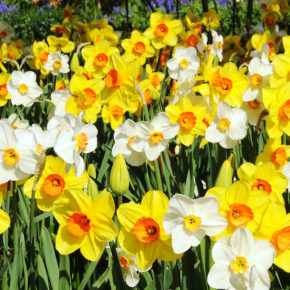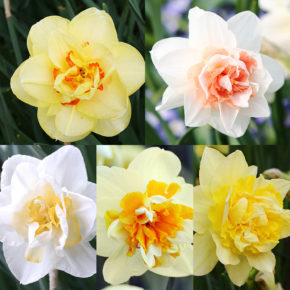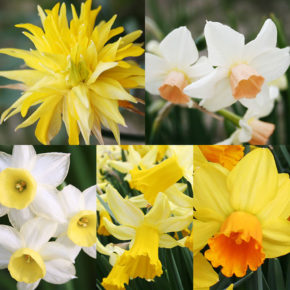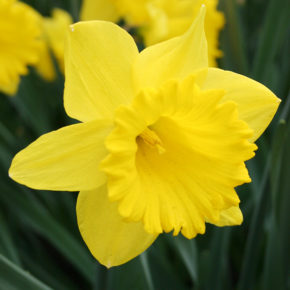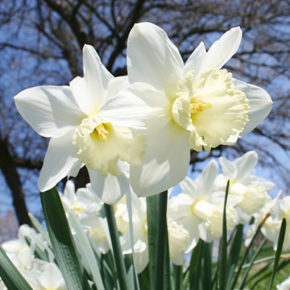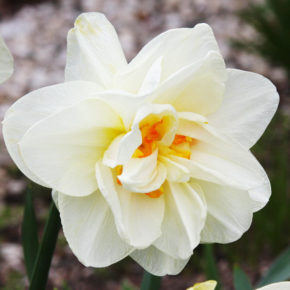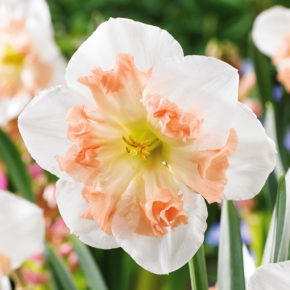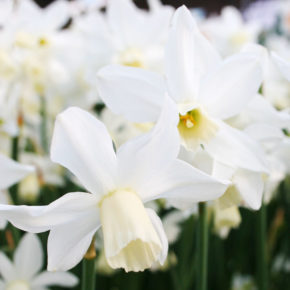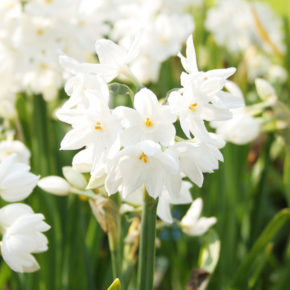He was so enamored by his handsome reflection in a pool of water that the gods punished him by turning him into a flower. Who was this boy? And what flower did they turn him into? The boy’s name was Narcissus. The flower the gods turned him into was the daffodil, which has the Latin name of Narcissus. This Greek mythological tale about Narcissus teaches about vanity and the importance of humility. It also gives an interesting background into a popular spring-blooming flower: the daffodil!
Daffodils are easy to grow and are one of my favorite flower bulbs to recommend for beginner gardeners. Easily recognizable by their bright blooms in early spring, the daffodil flower is adored by many. When I notice the first daffodils blooming in my neighborhood it is a sign that spring has truly arrived. Therefore, these beacons of spring and hope for warmer and brighter days are a critical flower in all home gardens. Daffodils are the bringers of light; by planting them this fall you will have a bright surprise to look forward to all winter.
When is the best time to plant daffodils?
Daffodils are a fall planted bulb that requires a dormant period of 12 or more weeks in order to flower in spring. The ideal planting time for daffodils will vary based on your location. The colder your winters are the earlier you will want to plant your daffodil bulbs in fall.
Planting season for daffodils begins as soon as the bulbs are available in stores and from online retailers like Holland Bulb Farms and Tulip World. People in hardiness zones 3 and 4 plant daffodils as early as mid-September and as late as mid-November—depending on when their ground freezes for the year. Gardeners in hardiness zones 5-6 will want to wait until October to begin planting, and in most years can plant as late as Thanksgiving—depending on when the ground freezes for the season.
Warm climates can make growing certain fall-planted bulbs a challenge. Fortunately, daffodils are among a few fall-planted bulbs that grow well in warm climates and southern gardens. Gardeners in hardiness zones 7 and 8 will be able to grow most varieties of daffodils without any special attention. Since hardiness zone 7 and 8 take a bit longer to cool down in fall it is best to hold off planting daffodils in warm climates until mid-November at the earliest and as late as early January.
For those fortunate enough to live in the warmest zones like 9 and 10 it is possible to grow certain varieties of daffodils, but chilling the bulbs before planting may be something to consider. When planting daffodils in hardiness zones 9 and 10 the best time to plant is December or early January when the temperatures have cooled, allowing for root development before the growing season which can begin in February.
Site Selection
To have success with daffodils there a couple of requirements, but for the most part, daffodils are considered easy to grow. The first requirement for success in growing daffodils is to plant the bulbs in soil that has good drainage. Flower bulbs do not tolerate sitting in wet soil. If water pools after a decent rainfall it is a good indication that the soil does not drain well. Before you plant you will want to amend the soil with plant starter mix, and/or compost.
The second requirement for success in growing daffodil bulbs is sunshine. Daffodils will tolerate some shade. However, to get the largest and boldest blooms from your daffodil bulbs plant them in an area that receives 6 or more hours of sun during the day. Note: If deciduous trees are in the planting area the sun will be different in winter and spring since the trees will not have leaves. This type of location will provide a sunnier location for the daffodils than it does in summer. The more sun your area receives the earlier your daffodils will appear in spring.
How to Plant Daffodils
Plant large daffodils 6-8” deep with the pointed end facing up. Smaller daffodil bulbs may be planted 4-6” deep, with the pointed end facing up. If there is mulch in the planting area be sure to factor that into the planting depth when you start digging.
Daffodil Colors
The two most recognizable daffodils to the average person are yellow with a single set of petals. In grocery stores and flower shops in late winter, it is common to see dwarf Tete a Tete Daffodils blooming in pots. Tete a Tete is one of the two most recognizable daffodils; the other daffodil that most people recognize is the common yellow daffodil, which could be an old King Alfred Daffodil, Dutch Master Daffodil or Carlton Daffodil. While the range in colors does not vary in daffodils as much as it does in tulips, there is much more to daffodils than yellow flowers.
Daffodils bloom in yellow, varying shades of white, orange and pink. Often pink daffodils tend to be on the salmon to apricot spectrum of pink more than a true pink seen in tulips. Two-toned blooms that have yellow petals and an orange cup are bright and cheery. Varieties with creamy white petals and orange or yellow blooms can often change color as the blooms age. For example, Mount Hood Daffodils begin with yellow cups and white petals, but after 4-6 days the yellow cups fade to white for a completely white bloom.
Types of Daffodils
When daffodils are mentioned confusion can arise because of the many names people use for these types of flowers. Some people refer to daffodils as narcissus, which is the Latin name as we mentioned earlier in this blog. If you’ve ever been confused about this think of it this way – those words are interchangeable; all daffodils are narcissus and all narcissus are daffodils. Southern gardeners may refer to daffodils as Jonquils, as that is a species of daffodil that grows particularly well in southern gardens. In this case, daffodils and jonquils are not interchangeable.
According to the Royal Horticultural Society, there are 12 classifications of daffodils. Daffodils fit into each classification based on subtle differences in how the flower parts are shaped. Most people chose what daffodils to plant in their garden based on the flower appearance and height of the flower and aren’t too concerned with the minor differences in the classifications. Therefore, I will only highlight some of the most popular classifications of daffodils and the main differences.
Trumpet Daffodils
These daffodils are what most people think of when you say daffodil. The cup of the flower which is the part that sticks out is longer than the petals that surround it. A couple of popular varieties of trumpet daffodils include Dutch Master Daffodil and Mount Hood Daffodil.
Large Cupped Daffodils
The average eye won’t be able to tell the difference between trumpet daffodils and large cupped daffodils. The main difference here is the cup is near the same size as the petals. Popular varieties of large cupped daffodils include Fortissimo Daffodil, Carlton Daffodil, and Ice Follies Daffodil.
Double Flowering Daffodils
Since daffodils are classified based on differences in the flowers this does not mean that double daffodils bloom twice. Double daffodils have double the number of petals compared to a traditional daffodil like a trumpet daffodil or large cupped daffodil. Some varieties such as Sir Winston Churchill Daffodil have double petals on the flower and multiple blooms on the stem which are smaller in diameter. Large flowering double daffodils such as Tahiti Double Daffodil have one large bloom per stem. Tahiti Double Daffodil is one of the most popular double flowering varieties due to its bright yellow blooms that have orange markings in the center of the petals.
Split Corona Daffodils
Commonly known as Butterfly Daffodils, this class of daffodils boasts some of the most unique daffodil blooms in the garden. The cup of the daffodil is split usually in half and has a more flat appearance than a cup appearance. One of my favorite butterfly daffodils is called Mallee Daffodil. About 6 or 7 years ago I planted a few groups of Mallee Daffodils in my front garden bed and they continue to bloom each spring. Their reliability as perennials is a nice bonus but the apricot and yellow cups are my favorite feature.
Jonquil Daffodils
Fragrant, dainty blooms are the key feature on these popular southern daffodils. These varieties feature up to 3 flowers per stem and tend to be smaller in size. They are sometimes confused with other dwarf daffodil varieties that are actually Tazetta Daffodils.
Tazetta Daffodils
Gardeners living in warm and southern climates will find they have success with Tazetta daffodils such as Geranium Tazetta Daffodil as they don’t require long cold periods to bloom. Tazetta Daffodils are fragrant and often have multiple blooms per stem. The popular holiday flower known as Paperwhites fall into the classification of Tazetta Daffodils.
Daffodils of Notable Mention
Other popular daffodils fall into less known classifications and should not be forgotten. Some of them include:
- Pheasant’s Eye Daffodils are from the poeticus group of daffodils and are known for their yellow cups that have a narrow red ring on the edge of the cup. They bloom late in the season compared to other daffodils.
- Thalia Daffodil is a pure white daffodil from the cyclamenieus classification. The petals on Thalia arch backward and the cup is small in size on these pure white, fragrant blooms.
- Rip Van Winkle Daffodil is named after an American fairytale based on a Dutch immigrant who gets lost in the woods in the Catskill Mountains. Its short growth habit and double blooms that almost resemble a dandelion are too cute to pass up. Plant Rip Van Winkle Daffodils in rock gardens, and at the front of the garden bed so you don’t miss these little guys.
Daffodils are Tough Garden Perennials
Daffodils are resilient bulbs that have good rates of returning to your garden for several years. In addition to their perennial nature daffodils are naturally pest resistant. If squirrels or deer are a problem in your yard you will fall in love with daffodils even more! Deer, squirrels, moles, and voles stay away from daffodils, adding to their resilience.
These tough, easy to grow perennials are a must-have flower in any garden. There are plenty of choices in flower color and shape when it comes to daffodils; the most difficult thing about planting daffodils this fall may be deciding which varieties to grow!


